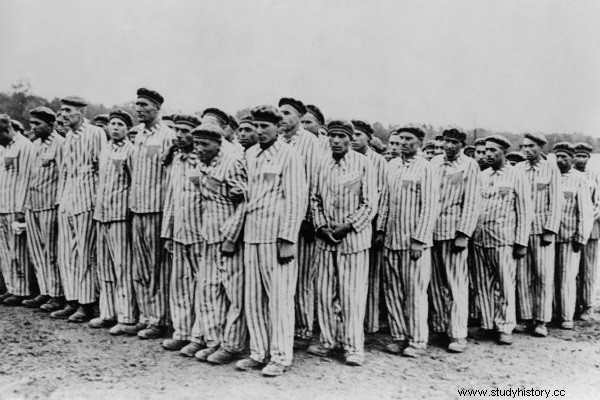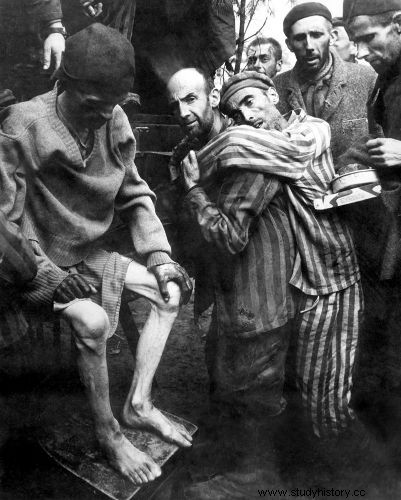Holocaust this is how the genocide of Jews carried out under the command of the Nazis during World War II became known. By the Jews he is known as Shoah , a Hebrew word meaning “calamity”. Throughout the war, the Nazis carried out systematic actions to exterminate this ethnic group, and the result was 6 million people dead .
The Nazis named their Jewish extermination program the Final Solution, and during this program communists, gypsies, homosexuals, Jehovah's Witnesses, people with physical and mental problems, etc. were also persecuted. Among the practices carried out in the Holocaust are the mass shooting of individuals, the use of prisoners as slave workers, imprisonment in ghettos and concentration camps, among others.
Login also :Eugenics:a fundamental element of Nazi ideology
How did the Holocaust start?

The Holocaust was not a casual and sudden event. The genocide of Jews across Europe was the result of a long road of persecution against these people and was a direct consequence of the strong anti-Semitism that existed across the continent. In the case of Germany, anti-Semitism was very strong since the 19th century.
First there are historians who argue that genocides like the Holocaust were based on the actions of neocolonialism. The cruelty and mass murders committed against different peoples in Africa have given practical force to anti-Semitic ideas. The Germans were even responsible for the genocide of the Herero people, who inhabited the region of present-day Namibia.
In the case of Jews in Germany, the first moment of this entire extermination process took place through hate speech . The rhetoric against them strengthened after the First World War and made them the scapegoat for the German defeat. All sorts of conspiracy theories came to be brewed against the Jews, and when the Nazis came to power, speech turned to action.
Thus the Jews were expelled from public service , then had their stores boycotted and attacked. Persecution on the streets increased considerably, and cases of physical violence began to occur. Then they were forbidden to marry non-Jews , citizenship applications for foreign Jews were denied, and German Jews were stripped of their citizenship .
Jews were deprived of their liberty and all rights as citizens. When the war started, the Nazis intensified the theft of their goods and began to group them in ghettos, in some parts of Europe. From the high command of the Nazi Party came the extermination order, and from that came all the horrors of the Holocaust.
Two important moments in anti-Semitism in Germany came with the Nuremberg Laws and the Grystals Night . Both served as important thermometers of the degree of hatred and prejudice against Jews and delimited the systematic advance against them in Germany.
Nuremberg Laws
The Nuremberg Laws were enacted in 1935 and established the principles for determination of German citizenship . Those who had ¾ of Jewish blood in their descent would not have the right to German citizenship. Thus, Jews were defined only as “subjects of the State”, that is, they had no rights, but had to fulfill their civil obligations.
Through these laws, marriage between Jews and non-Jews, as well as sexual relations between Jews and non-Jews, was prohibited, and anyone who did not comply was accused of “corruption sexual ”. Jews were also banned from hiring German maids under the age of 45.
Grystals Night

The Crystal Night was a pogrom , that is, a coordinated violent attack against a certain group which, in this case, were the Jews. This attack was ordered by the Nazi leadership itself and carried out at the turn of the 9th to the 10th of November 1938. The attack spread throughout Germany, with Jews being attacked in their homes, in addition to having their shops, and even synagogues. , destroyed throughout the country.
The Crystal Night resulted in the destruction of over 1,000 synagogues and the probable death of over 1,000 people, although the official figure states that only 91 people were killed. Crystal Night also started the imprisonment of Jews in concentration camps, as 30,000 of them were arrested and sent to the Buchenwald, Dachau and Sachsenhausen camps.
Login also :Ustasha - Fascist government installed by the Nazis in Croatia during World War II
Final Solution
After the beginning of the Second World War, a very important debate within the Nazi Party was “the Jewish question”. Adolf Hitler's initial idea was to promote the extermination of Jews after the German victory in this conflict. Meanwhile, the Nazis kept imprisoning them and promoting all kinds of nonsense against them.
Violence against Jews was considerably higher in Eastern Europe. In Poland, for example, they were forced to move to ghettos, where thousands of them were herded onto a small piece of land. Jews were already subject to forced labor in Germany, and with the war, this extended to that portion of the continent.
A series of ideas, in this sense, were proposed by the Nazi leadership, such as the deportation of Jews to the Soviet Union and to Madagascar, in Africa. However, as the Nazis lost control of the war, actions against this ethnic group became more radical. Until Reinhard Heydrich and Heinrich Himmler devised the plan known as the Final Solution.
The name Final Solution was used by the Nazis as a euphemism for the extermination of the Jews. This plan stipulated that they must be physically eliminated, and this started a series of actions. In this text we will highlight the role of the Einsatzgruppen (extermination groups) and the concentration camps created during the Holocaust.
-
Slayer teams
The action of these groups took place in Eastern Europe and became a priority for the Germans in the war, as the objectives of territorial conquest were not achieved. In late 1941 , the Nazis' position towards Jews was that those who could not work would be summarily executed.
In some regions of Eastern Europe, death squads carried out a cleansing ethnic without caring about the use of Jews as labor. Known as Einsatzgruppen , the death squads included members of the German army, the SS (paramilitary organization — Schutzstaffel ) and the Nazi police.
The extermination groups acted behind German lines, that is, they acted in the regions already dominated by the Nazis, and they did so in four large groups. The role of the death squads was to round up all the Jews in a certain locality, execute them, and bury them in mass graves . The four groups became known as Einsatzgruppe A, Einsatzgruppe B, Einsatzgruppe C and Einsatzgruppe D.
Death groups carried out ethnic cleansing through mass shootings . In places like Lithuania, these groups were responsible for the deaths of more than 110,000 Jews. A well-known example of the modus operandi of the death squads came with the Babi Yar Massacre , which took place in September 1941.
This massacre took place in revenge by the Nazis against an attack by the Soviet resistance on a Nazi-occupied building in Kiev. After that the Nazis ordered the shooting of all Jews in Kiev, and in 36 hours , 33,761 Jews were shot and placed in mass graves.
Historian Timothy Snyder claimed that the action of extermination groups was responsible for the death of 1 million Jews during the entire Second World War|1|. The US Holocaust Memorial Museum claims they were responsible for the deaths of at least 1.5 million Jews|2|.
Concentration camps

The concentration camps were places found by the Nazis to enlarge the extermination of the Jews in Europe, since the Einsatzgruppen they could not carry out the killing at the speed that the German situation in the war demanded. In this way, many Jews were sent to concentration camps, and when they were no longer needed, they went to the death camps.
Concentration camps executed Jews through gas chambers . In them, they could die from the use of carbon monoxide , which asphyxiated its victims, or Zyklon-B , a pesticide that, when heated, released a gas that guaranteed the victim's death by acute intoxication. The use of the gas chamber was an idea taken from Aktion T4 — program by which the Nazis executed people with mental disorders or physical disabilities.
The death camps created by the Nazis to deal with the “Jewish question” were:Auschwitz-Birkenau , Belzec , Chelmno , Majdanek , Sobibor and Treblinka . Adding up all these camps, it is stipulated that they killed3 million people . In Auschwitz-Birkenau alone, approximately 1.2 million people died.
In addition to executions, Jews could also die from a variety of factors related to the daily treatment they received. The exhausting work, the routine violence, the bad diet and the terrible living and hygiene conditions meant that thousands more of them died of exhaustion, starvation and various diseases.
How did the Holocaust end?

The Holocaust ended with the defeat of Nazi Germany in Second World War. Thus, as the Nazis lost territory, the concentration camps were liberated by the Allied forces and their prisoners released. Both the Soviets and the Americans carried out this release. As mentioned, the death toll at the end of the Holocaust was 6 million people.
After the German defeat, dozens of Nazi officers were tried at the International Military Tribunal in Nuremberg for war crimes and crimes against humanity, including the actions of the Holocaust. Among those tried, there were death sentences, life imprisonment, temporary imprisonment and acquittals.
Login also :Is it true that there were concentration camps in the US?
Movies
The Holocaust is one of the most addressed historical themes in cinema, and therefore there is a wide variety of productions that address it. Among the films, some titles are:
-
Schindler's List (1993), directed by Steven Spielberg.
-
The boy in the striped pajamas (2008), directed by Mark Herman.
-
The Pianist (2002), directed by Roman Polanski.
-
Life is beautiful (1997), directed by Roberto Benigni.
-
Amen (2002), directed by Constantin Costa-Gavras.
-
The son of Saul (2015), directed by László Nemes.
-
Anne Frank's Diary (1959), directed by George Stevens.
Notes
|1| SNYDER, Timothy. Lands of Blood :Europe between Hitler and Stalin. Rio de Janeiro:Record, 2012. p. 237.
|2| Einsatzgruppen :an overview. To access, click here [in English].
Image credits
[1] Everett Historical and Shutterstock
